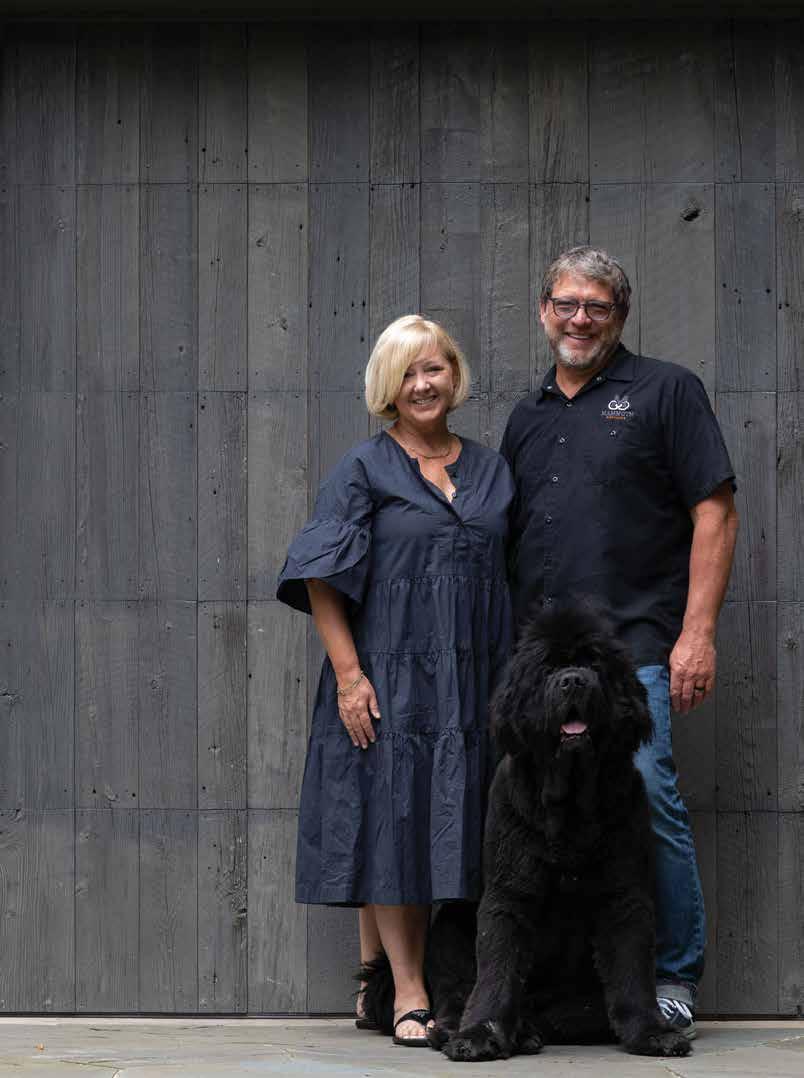
A Story 100 Years In The Making With Mammoth Distilling Great Lakes Energy Cooperative COUNTRY LINES November/December 2022 MICHIGAN A Front-Row Seat To History Making Spirits Bright Get Energy Wise

You may not realize it, but your home is sitting on a free and renewable supply of energy. A WaterFurnace geothermal comfort system taps into the stored solar energy in your own backyard to provide savings of up to 70% on heating, cooling, and hot water. That’s money in the bank and a smart investment in your family’s comfort. Contact your local WaterFurnace dealer today to learn how to tap into your buried treasure. WATERFURNACE UNITS QUALIFY FOR A 30% FEDERAL TAX CREDIT THROUGH 2032 YOUR LOCAL WATERFURNACE DEALERS THERE’S A TREASURE IN YOUR BACKYARD visit us at waterfurnace.com WaterFurnace is a registered trademark of WaterFurnace International, Inc. Allendale Allendale Htg & Clg (800) 327-1937 allendaleheating.com Bad Axe/Ubly Cutting Edge Htg & Clg (989) 551-0986 Berrien Springs Waterfurnace Michiana (269) 473-5667 gogreenmichgeo thermal.com Big Rapids Stratz Htg & Clg, Inc. (231) 796-3717 stratzgeocomfort.com Clifford Orton Refrig & Htg (989) 761-7691 sanduskygeothermal.com Hart Adams Htg & Clg (231) 873-2665 adamsheating cooling.com Indian River M&M Plmb & Htg (231) 238-7201 mm-plumbing.com Lansing Candor Mechanical (517) 920-0890 candormechanical.com Mancelona Top Notch Htg, Clg, & Geothermal (231) 350-8052 Topnotchheatandair.com Michigan Center Comfort 1/Air Serv of Southern Michigan (517) 764-1500 airserv.com/southernmichigan/ Mt Pleasant Walton Htg & Clg (989) 772-4822 waltonheating.com Muskegon Adams Htg & Clg (231) 873-2665 adamsheatingcooling.com Portland ESI Htg & Clg (517) 647-6906 esiheating.com Sunfield Mark Woodman Plmb & Htg (517) 886-1138 mwphonline.com Traverse City D&W Mechanical (231) 941-1251 dwmechanical.com Geofurnace Htg & Clg (231) 943-1000 geofurnace.com
Michigan’s Electric Cooperatives
EXECUTIVE
Karreen
EDITOR: Christin McKamey

COPY EDITOR: Yvette Pecha
CONTRIBUTING EDITOR: Emily Haines Lloyd
PUBLISHER: Michigan Electric Cooperative Association
Michigan Country Lines, USPS-591-710, is published monthly, except August and December, with periodicals postage paid at Lansing, Mich., and additional offices. It is the official publication of the Michigan Electric Cooperative Association, 201 Townsend St., Suite 900, Lansing, MI 48933.
Subscriptions are authorized for members of Alger Delta, Cherryland, Great Lakes, HomeWorks Tri-County, Midwest Energy & Communications, Ontonagon, Presque Isle, and Thumb electric cooperatives by their boards of directors.
Postmaster: Send all UAA to CFS.
Association Officers: Tom Sobeck, Presque Isle Electric & Gas Co-op, chairman; Gabe Schneider, Cherryland Electric Cooperative, vice chairman; Chris O’Neill , HomeWorks Tri-County Cooperative, secretary-treasurer; Craig Borr , president and CEO.
CONTACT US/LETTERS TO EDITOR: Michigan Country Lines 201 Townsend St., Suite 900 Lansing, MI 48933
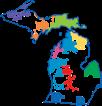
248-534-7358
editor@countrylines.com

Cooperative Association,
Townsend St., Ste. 900, Lansing,
On
November/December 2022 Vol. 42, No. 10 /michigancountrylines /michigancountrylinescountrylines.com
the Cover: Owners of Mammoth Distilling Chad Munger, wife Tracy Hickman, and their distillery dog Dawson. Photo courtesy of Sandra Wong 6 ENERGY ASSISTANCE PROGRAMS FOR 2022-2023 10 MI CO-OP KITCHEN Holiday Side Dishes: The perfect pairings for your festive feast. 14 100 YEARS IN THE MAKING The rediscovery of Michigan Rosen rye took equal parts of serendipity, location, teamwork and passion. 18 GUEST COLUMN The Salted Christmas Goose: A HomeWorks member recalls how a cooking catastrophe created better family communication. #micoopcommunity Instagram contest winner Flowers give this old Ford a facelift @lexannrebecca (LexAnn DeWeerd) MI Co-op Community To enter contests, submit reader content & more, visit countrylines.com/community Guest Column See details on page 18. Win $150 for stories published! Recipe Contest See details on page 10. Win a $50 bill credit! Instagram Contest Use #micoopcommunity for a chance to be featured here and on our Instagram account. CHANGE OF ADDRESS: Please notify your electric cooperative. See page 4 for contact information. The appearance of advertising does not constitute an endorsement of the products or services advertised.
EDITOR: Casey Clark EDITOR: Christine Dorr GRAPHIC DESIGNER:
Bird RECIPE
Statement of Ownership, Management and Circulation (Required by U.S.C. 3685) 1. Publication: Michigan Country Lines. 2. Publication No.: 591-710. 3. Filing date: 10/1/22. 4. Issue frequency: monthly, except Aug. and Dec. 5. No. of issues published annually: 10. 6. Complete mailing address of office of publication: Michigan Electric
201
MI 48933. 7. Complete mailing address of headquarters of publisher: 201 Townsend St., Ste. 900, Lansing, MI 48933. 8. Full names and complete mailing address of publisher, editors, and executive editor: Craig Borr, Christine Dorr, Casey Clark, 201 Townsend St., Ste. 900, Lansing, MI 48933. 9. Owner: Michigan Electric Cooperative Assoc., 201 Townsend St., Ste. 900, Lansing, MI 48933. 10. Known bondholders, mortgagees, and other security holders owning or holding 1% or more of total amount of bonds, mortgages, or other securities: None. 11. Tax status: has not been changed. 12. Issue date for circulation data: Sept. 2022. 13. Extent and nature of circulation: A) Total No. of copies 245,503 246,919 B) Paid and requested circulation 244,543 246,070 C) Total paid and requested circulation 244,543 246,070 D) 1) Free distribution by mail 157 157 2) Free distribution outside mail 809 849 E) Total free distribution 966 1,006 F) Total distribution 246,469 247,925 G) Copies not distributed 0 0 H) Total 246,469 247,925 I) Percent paid and/or requested circ 98.7 99.7% Avg # of copies each issue during preceding 12 mo. Actual # of copies of single issues published nearest to filing date 16. Publication of statement of ownership: November 2022 17. Signature and title of editor: Christine Dorr, editor Contents 3MICHIGAN COUNTRY LINES
BOARD OF DIRECTORS
Howard Bowersox, Chairman, District 8 219-670-0977
hbowersox@glenergy.com
Mark Carson, Vice Chairman, District 2 231-675-0561
mcarson@glenergy.com
Paul Byl, Secretary, District 7 231-861-5911
pbyl@glenergy.com
Dale Farrier, Treasurer, District 5 231-564-0853
dfarrier@glenergy.com
Janet Andersen, Director, District 6 231-690-4622
jandersen@glenergy.com
David Coveyou, Director, District 1 231-347-4056 dcoveyou@glenergy.com
Richard Evans, Director, District 3 231-883-3146
revans@glenergy.com
John LaForge, Director, District 9 269-623-2284

jlaforge@glenergy.com
Shelly Pinkelman, Director, District 4 989-390-6222 spinkelman@glenergy.com
PRESIDENT/CEO: Shaun Lamp 888-485-2537
COMMUNICATIONS DIRECTOR/EDITOR: Brett Streby 231-487-1389 • bstreby@glenergy.com
BOYNE CITY HEADQUARTERS
1323 Boyne Ave. Boyne City, MI 49712
Call center hours:: 7 a.m.–5:30 p.m. M–F
888-485-2537
glenergy@glenergy.com
TO
888-485-2537,
Great Lakes Energy is an
Rising Costs Are Affecting Us All
Shaun Lamp, Great Lakes Energy President/CEO
Among the many issues that have dominated headlines recently, the rising cost of goods and services, also known as inflation, has taken center stage. From groceries to gas and just about everything in between, costs have gone up noticeably.
Just like rising costs can put a pinch on your household budget, they also affect organizations such as Great Lakes Energy.
As part of our mission to deliver reliable electric service at the best possible value for our members, it’s important that we regularly review our rates to make sure we can continue to sustainably provide our services in today’s economic climate.
The world has changed considerably since we last adjusted our rates in 2018. Most notably, the inflation that would normally have occurred in that time frame has been disproportionally magnified because of a worldwide pandemic and several other factors. For electric utilities such as GLE, standard equipment and materials, such as copper wire, have more than doubled in cost from what they were just five years prior.
About every five years, we ask independent industry experts for a cost-ofservice study to review our rate structures. As a not-for-profit cooperative, we want to ensure that what we charge for electricity adequately and fairly covers the costs to safely and reliably provide this service to our members.
Following a cost-of-service study completed earlier this year, our consulting firm determined rate adjustments are required. Based on these recommendations, during a meeting on Sept. 21 that was open to all members, the Great Lakes Energy Board of Directors approved an increase of $2 to the base monthly charge and $0.007 per kilowatt hour for energy use for residential and seasonal rate classes. These increases will take effect on bills starting Jan. 1, 2023.
For the average residential member using 800 kWh per month, these changes will equate to a $7.90 monthly cost increase. Visit www.gtlakes.com/faq for additional information regarding these adjustments.
While these increases are an unfortunate reality of doing business, having properly adjusted rates allows us to make the investments necessary to maintain the high level of system reliability and quick restoration response you have come to expect from your electric cooperative.
The good news is that GLE offers its members many opportunities to control their monthly bills. From monitoring daily usage through our mobile app or online account, to rebates for the replacement of home appliances or complete HVAC systems with energy-efficient alternatives through the Energy Wise program, to payment assistance plans such as the Pathways Program, our members have a wide array of tools available to help minimize the impact of this adjustment.
As a member-owned cooperative, our members’ needs are always our top priority. To that end, our goal is to target the lowest cost possible without sacrificing quality and reliability. These measures for success, which don’t include any concern for investor profits, are part of what makes cooperatives so great.
Phone:
Email:
REPORT AN OUTAGE: Call 888-485-2537 or login to your account at gtlakes.com.
equal opportunity provider and employer. Change of Address:
ext. 8924 /greatlakesenergy gtlakes.com /jointruestream 4 NOVEMBER/DECEMBER 2022
Get Energy Wise

Nowadays, it seems like the cost of just about everything is rising. In many cases, there isn’t much we can do to offset these increased costs. Fortunately, Great Lakes Energy offers a host of energy-saving opportunities that can help you lower energy usage—and costs, year-round. Earlier this year, GLE rolled out the Energy Wise program to replace the former Energy Optimization program. The Energy Wise program offers GLE members incentives in the form of rebates when they purchase qualifying energy-efficient appliances, HVAC systems, and other equipment. Here’s a look at some of the most popular rebates available through the Energy Wise program:
Home appliances
Besides heating and cooling systems, home appliances are among the biggest electricity users in our homes. Energy Wise offers rebates for a wide assortment of ENERGY STAR-qualified appliances. Members can receive $25 rebates for the purchase of qualified room dehumidifiers, room air conditioners, and portable air purifiers; and $50 for qualified refrigerators, freezers, washing machines, and clothes dryers. A rebate of $50 is available on the purchase of a qualified electric lawn mower and $75 on a smart occupancy-sensing thermostat.
Appliance recycling
Of course, after you’ve taken advantage of one or more appliance rebates, you’ll need to get rid of that old, inefficient appliance you replaced. The Energy Wise program has that covered, too. The program hosted an appliance recycling



drop-off day in August at three GLE office locations. Dehumidifiers, room air conditioners, refrigerators, and freezers were eligible for the program. Members who took advantage of the program also received $25 per eligible appliance (limits apply). A total of 159 appliances were collected at the three locations. Watch for announcements next year for when the 2023 drop-off day will take place.
Heating and cooling
Heating and cooling our homes requires a lot of energy, but the Energy Wise program offers incentives on several energy-efficient heat pump systems that can significantly cut those costs. A heat pump moves heat into or out of your home, depending on the season. Air-source heat pumps use the air outside your home, while ground-source heat pumps use the relatively constant temperature of the ground outside your home. Rebates for installing qualified heat pump systems range from $500 to $2,500. Additionally, members who use a heat pump system as the primary source of heat in their homes may qualify for a lower electric rate for the energy the heat pump system uses.
Many other rebates are also available through the Energy Wise program for other home-based equipment, electric vehicle chargers, and commercial and industrial products. More information on all the incentives offered through the Energy Wise program, including the forms needed to claim rebates, are available online at gtlakes.com/ energy-wise/. Forms may also be submitted through the website. Forms and more information are also available by calling (888) 485-2537.
Whether gas or electric, water heaters are the second-highest source of energy use in your home. S A V I N G S ! *Restrictions may apply Make smarter choices with Energy Wise. Call 88 8- 476 9534 or visit gtlakes com/energy wise today! P U M P U P T H E Not ready to invest in a heat pump water heater? $100* rebates for electric resistance water heaters are also available Real savings are available when you convert your regular water heater to a heat pump water heater. Not only are they two to three times more energy efficient, but Great Lakes Energy members are eligible for a $1, 200* rebate for qualified heat pump water heaters.
Energy
Winter Protection Plan
Contact: Your Local Utility Company
#
The Winter Protection Plan (WPP) protects enrolled seniors and low-income customers from service shut-offs and high utility bill payments during the winter months. If you are eligible, your utility service will remain on (or restored with the WPP) from Nov. 1 through March 31, if you:
• pay at least 7% of your estimated annual bill each month, and
• make equal monthly payments between the date you apply and the start of the next heating season on any past-due bills.
When the protection period ends (March 31), you must begin to pay the full monthly bill, plus part of the amount you owe from the winter months when you did not pay the full bill. Participation does not relieve customers from the responsibility of paying for electricity and natural gas usage, but does prevent shut-off during winter months. You qualify for the plan if you meet at least one of the following requirements:
• are age 65 or older,
• receive Dept. of Health and Human Services cash assistance, including SSI,
receive Food Assistance,
receive Medicaid, or
• household income is at or below the 150% of poverty level shown in the Income Guidelines chart above.
Senior citizen customers who participate in the WPP are not required to make specific payments to ensure that their service will not be shut off between Nov. 1 and March 31. Service for seniors can be restored without any payments.
Note: All customers 65+ are eligible regardless of income. Customers are responsible for all electricity and natural gas used. At the end of the protection period, participants must make arrangements with their utility company to pay off any money owed before the next heating season.
Earned Income Credit
Contact:
• U.S. Treasury Dept., Internal Revenue Service, irs.gov/EITC
• Michigan Dept. of Treasury, michigan.gov/treasury
The Earned Income Tax Credit (EITC) is a refundable federal income tax credit for lowincome working individuals and families who meet certain requirements and file a tax return. Those who qualify will owe less in taxes and may get a refund. Even a person who does not generally owe income tax may qualify for the EITC, but must file a tax return to do so. If married, you must file jointly to qualify. File Form 1040 or 1040A and attach the EITC.
You may claim a Michigan earned income tax credit for tax year 2021 equal to a percentage of the federal earned income tax credit for which you are eligible.
State Emergency Relief Program (SER)
Contact: Local Michigan Dept. of Health and Human Services
michigan.gov/mdhhs
You do not have to be a DHHS client to apply for help with a past-due bill, shut-off
or the need for deliverable fuel through the SER. This program, available Nov. 1–May 31, provides most of its utility assistance during this crisis season. However, limited assistance is available outside the crisis season.
you receive a DHHS cash grant, you may use part of it toward heat and electric bills. Apply online using MI Bridges: Michigan.gov/mibridges.
Low-Income Weatherization Assistance Program
Contact: Local Community Action Agency
You may be able to receive help with weatherizing your home to reduce energy use if you meet low-income eligibility guidelines (200% of poverty guidelines) or if you participate in the Dept. of Health and Human Services Family Independence Program or receive SSI. Weatherization may include caulking, weatherstripping, and insulation. Contact your local Community Action Agency for details. Visit mcaaa.org to find one in your area.
United Way
Contact: Call 2-1-1 or UWmich.org/2-1-1
2-1-1 is a free phone service operating 24 hours daily to provide information about help that may be available in a particular area with utilities and other needs. Dial 2-1-1 or visit mi211.org to find available services.
Medical Emergency Protection
Contact: Local Utility Company
You are protected from service shut-off for nonpayment of your natural gas and/ or electric bill for up to 21 days, possibly extending to 63 days, if you have a proven medical emergency. You must provide written proof from a doctor or a public health or social services official that a medical condition exists. Contact your gas or electric utility for details.
Shut-off Protection For Military Active Duty
Contact: Local Utility Company
or
later than Sept. 30 each year.
must be filed
If you or your spouse has been called into active military duty, you may apply for shut-off protection from your electric or natural gas service for up to 90 days. You may request extensions. You must still pay, but contact your utility company and they will help you set up a payment plan.
Income Guidelines 2022–2023
in Household 150% Poverty Guide Maximum Income 1 $20,385 2 27,465 3 34,545 4 41,625 5 48,705 6 55,785 7 62,865 8 69,945 Add $7,080 for each additional household member.
•
•
Assistance Programs 2022-2023 Season Home Heating Credit Contact: Michigan Dept. of Treasury # Exemp. Max. Income # Exemp. Max. Income 0–1 $14,949 5 $35,717 2 20,141 6 40,909 3 25,333 7 46,101 4 30,525 8 51,293 Add $5,192 for each exemption over 6. You can apply for a Home Heating Credit for the 2022 tax year if you meet the income guidelines listed above (110% of poverty level) or you qualify based on alternate guidelines including household income, exemptions, and heating costs. Additional exemptions are available for seniors, disabled claimants, or claimants with 5% or more of their income from unemployment compensation. If you qualify, you may receive assistance to help pay for your winter heating bills. Forms are available mid-to-late January wherever tax forms are provided or from the Michigan Dept. of Treasury (517-636-4486
michigan.gov/treasury). The Home Heating Credit claim form
with the Michigan Dept. of Treasury no
(DHHS),
notice,
If
6 NOVEMBER/DECEMBER 2022
Michigan Veterans Trust Fund Emergency Grant Program
Contact: MI Veterans Trust Fund
The Trust Fund provides temporary assistance to veterans and their families facing a financial emergency or hardship, including the need for energy assistance. Contact the Michigan Veterans Trust Fund at 800-642-4838 or michiganveterans.com.
Michigan Homeowner Assistance Fund Administering Agency: Michigan State Housing Development Authority
The MIHAF provides funds to customers with assistance preventing homeowner mortgage delinquencies, defaults, foreclosure, loss of utilities or home energy services, and displacement. Applicants must demonstrate financial hardship directly related to COVID-19 on or after Jan. 21, 2020.
MI Energy Assistance Program
Contact: Utility or 2-1-1 in late November
The Michigan Energy Assistance Program (MEAP) includes services that will enable participants to become self-sufficient, including assisting participants in paying their energy bills on time, budgeting for and contributing to their ability to provide for energy expenses, and being energy efficient. Shut-off protection is provided
Nov. 1–April 15 for all residential customers. The MEAP is supported by the state’s Low-Income Energy Assistance Fund (LIEAF). An electric utility that chooses not to collect for the LIEAF shall not shut off service to customers for nonpayment between Nov. 1 and April 15. For a list of electric providers that opt out of collecting the LIEAF, go to michigan.gov/energygrants.
Holiday Tips
The holidays are a magical time, and it’s also the most expensive time of year for many of us. Here are tips to reduce the financial burden with efficient ways to use less energy at home and lower your monthly bills.
Home Practices
If you are hosting guests, your household will consume more electricity than normal. Be prepared with efficiency basics:
• Have your thermostat programmed at 68 degrees when you are home and dialed back by eight to 10 degrees when you leave the house or go to sleep.
• Run the clothes washer on cold with full loads.
• When not in use, turn off lights and the TV; fully shut down computers and gaming systems instead of putting them in sleep or standby mode.
Cooking Efficiency
• Use the oven light to check the food. Every time the oven door is opened, the temperature inside is reduced by up to 25 degrees, according to the Department of Energy (DOE).
• When possible, make use of a slow cooker, microwave, toaster oven, or warming plate, which uses less energy than an oven and stovetop.
• Let hot food cool to room temperature before placing it inside the refrigerator. This ensures you don’t increase the temperature inside your fridge and cause it to use more energy to cool down.
Holiday Lighting
• LED holiday lights consume 70% less energy than conventional incandescent light strands.
• Use light timers so you don’t have to remember to unplug your lights every evening. You can also choose to upgrade to smart holiday lights that offer a wide range of app-controlled options, including time, colors, music, and modes.
Out-of-Town Efficiency
If you’re visiting family and friends during the holidays, prepare your home to use less energy while you’re away.
• Water heating is the second-largest energy expense in your home, accounting for about 18% of your utility bill, according to DOE. Switching your water heater to vacation mode will reduce wasted energy by keeping the water at a lower temperature. If your water heater does not have vacation mode on the dial, you can adjust it to the lowest setting.
• Set your thermostat to around 55 degrees so you’re not wasting energy to heat the home while you’re away.
• Consider upgrading a lamp or fi xture to a smart lightbulb. This allows you to control lights from afar and set a schedule for the light to go on and off.
Dial 2-1-1 for more information on heating and other human services programs.
7MICHIGAN COUNTRY LINES
Board Approves Rate Changes
Rising power supply costs and inflation are affecting our costs to provide service. In order to balance affordability with sustainable and reliable service, at a special board meeting on Sept. 21, the Great Lakes Energy Board of Directors approved rate changes affecting all rate classes. These rate changes are based on an independent cost-of-service study conducted earlier this year.
For residential and seasonal rates, the changes include an increase of
$.00700 per kWh, and a $2.00 increase in the fixed monthly charge. These new rates will be reflected on billings beginning in January 2023. Other changes may go into effect on or after Dec. 1, 2022.
For the average residential member using 800 kWh per month, this equates to a $7.90 monthly increase.
The increase, although small, would raise revenues to provide sufficient funding levels for maintaining reliable
electric service, providing adequate margins, and ensuring members receive the service they need to power their homes and businesses.
The board also approved changes to the terms of conditions of service, construction fees and policies, outdoor lighting options, Energy Optimization rates for commercial and industrial accounts, and a tariff for radio frequency meter service opt-out. For details, visit gtlakes.com/faq.
Approved Adjustments For Residential And Seasonal Members
Notice to Members of Great Lakes Energy Cooperative Rates and Tariffs Changes
Effective on or after Dec. 1, 2022
The Great Lakes Energy Electric Cooperative Board of Directors, at a special open meeting held Sept. 21, 2022, acted on several matters:
1. Approved changes to the Energy Optimization program rates for D-APM, PSDS-General, PSDS-1, and PSDS-2 rate classes.
2. Approved a non-standard metering provision.
3. Approved changes to the terms and conditions of service, construction fees and policies, and the outdoor lighting service options.
4. Revised the Cooperative’s rates to take effect on or after Jan. 1, 2023, to meet current and future financial needs, based on an independent cost-of-service study.
For specific details on changes to Great Lakes Energy’s tariffs or fees, please visit www.gtlakes.com or contact 888485-2537.

Fuel Mix Report The fuel mix characteristics of Great Lakes Energy Cooperative as required by Public Act 141 of 2000 for the 12-month period ending 6/30/22. Comparison Of Fuel Sources Used NOTE: Biomass excludes wood; solid waste incineration includes landfill gas; and wind includes a long-term renewable purchase power contract in Wolverine’s mix. Fuel source Your co-op’s fuel mix Regional average fuel mix Coal 21.85% 36.27% Oil 0.20% 0.39% Gas 17.13% 26.18% Hydroelectric 0.56% 0.87% Nuclear 41.79% 27.82% Renewable Fuels 18.47% 8.47% Biofuel 0.34% 0.71% Biomass 0.20% 0.47% Solar 0.66% 0.32% Solid Waste Incineration 0.10% 0.05% Wind 16.96% 6.50% Wood 0.21% 0.42% Your Co-op’s Fuel Mix Regional Average Fuel Mix Emissions And Waste Comparison *Regional average information was obtained from the MPSC website and is for the 12-month period ending 12/31/21. Great Lakes Energy purchases 100% of its electricity from Wolverine Power Supply Cooperative, Inc., which provided this fuel mix and environmental data. Type of emission/waste lbs/MWh Your co-op Regional average* Sulfur Dioxide 0.62 1.16 Carbon Dioxide 676.4 1,133.0 Oxides of Nitrogen 0.43 0.82 High-Level Nuclear Waste 0.0090 0.0060
8 NOVEMBER/DECEMBER 2022
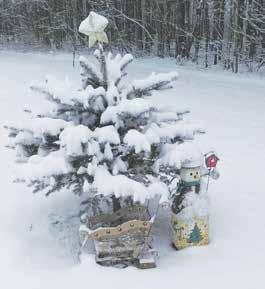
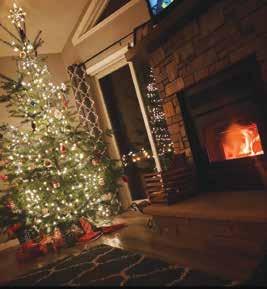




Christmas Trees 1. Warm and cozy—Michelle Seelye, Boyne City 2. Love and joy on Christmas morning!—Benjamin Eavey, New Era 3. Ryder’s first Christmas—Diane Dowdall, Central Lake 4. Candy sprinkles Christmas tree—Sheila Melke, Charlevoix 5. All is calm, all is bright—Shalene Sommer, Central Lake 6. Matthew’s Christmas tree—Martha Parrott, White Cloud PHOTO CONTEST GREAT LAKES ENERGY Submit Your “Family Time” Photos By Nov. 20! Each month, members can submit photos on our website for our photo contest. The photo with the most votes is published here, along with other selections. Our November/December theme is Family Time. Photos can be submitted by Nov. 20 to be featured in the February issue. How To Enter: Enter the contest at gtlakes.com/photocontest/. Make sure to vote and encourage others to vote for you, too. The photo receiving the most votes will be printed in an issue of Michigan Country Lines along with other favorites. All photos printed in the magazine in 2023 will be entered to win a $200 bill credit in December 2023. Enter to win a $200 energy bill credit! 1 2 3 5 64 MOST VOTES! 9MICHIGAN COUNTRY LINES

Photos by Robert Bruce Photography || Recipes Submitted by MCL Readers and Tested by Recipe Editor Christin McKameyMI CO-OP Recipes TASTY TUSCAN BUTTER MUSHROOMS Deb Finedell, Great Lakes Energy 4 tablespoons butter 2 cloves garlic, minced 1 tablespoon tomato paste 1 pound baby bella mushrooms, cleaned 1 cup cherry tomatoes, halved ¼ cup heavy cream ¼ cup freshly grated Parmesan cheese ¼ teaspoon salt ¼ teaspoon ground black pepper ¹⁄ 8 –¼ teaspoon crushed red pepper flakes 3 cups fresh spinach • chopped fresh basil, for garnish Melt butter in a large skillet over medium heat. Add garlic and tomato paste and cook until fragrant (about 1 minute). Add mushrooms and tomatoes and cook until mushrooms are tender and tomatoes start to burst, about 5 minutes. Add heavy cream and Parmesan, and season with salt, pepper, and crushed red pepper flakes. Bring to a simmer. Add spinach and cook until sauce is thickened and spinach is wilted, stirring occasionally for about 5 minutes. Garnish with basil before serving. Enjoy! Watch a video of this month’s winning recipe at micoopkitchen.com/videos WINNING RECIPE! RECIPE CONTEST National Cherry Month due Dec. 1 • Fish Fry due Jan. 1 • Vegetarian due Feb. 1 Submit your favorite recipe for a chance to win a $50 bill credit and have your recipe featured in Country Lines with a photo and a video. Submit your recipe at micoopkitchen.com, or send it via email (include your full name and co-op) to recipes@countrylines.com. Win a $50 energy bill credit! HOLIDAY SIDE DISHES Serve alongside your holiday dinner. 10 NOVEMBER/DECEMBER 2022
ZUCCHINI CASSEROLE

1 package chicken stuffing
6 cups sliced zucchini
onion
1 (15-ounce) can cream of mushroom soup
1
1
cream
carrots
butter
Preheat oven to 350 F. Prepare chicken stuffing according to package directions.
Fill a saucepan with salted water and bring to a boil. Add sliced zucchini and chopped onion. Boil for 5 minutes; drain well. In a bowl, combine soup and sour cream. Stir in carrots. Fold in drained zucchini and onion. Combine stuffing with butter. Spread ½ of the stuffing mix in bottom of 10x7x2-inch baking pan. Spoon zucchini mixture on top. Sprinkle remaining stuffing on top. Bake for 30 minutes. Serve immediately.

1 head cauliflower
1 stick butter
MASHED CAULIFLOWER

Jane Ellison, Great Lakes Energy
1 (12-ounce) package cream cheese
1 cup shredded cheddar cheese

1 tablespoon horseradish
• salt and pepper, to taste
Cut cauliflower into just bigger than bite size. Steam the cauliflower for 30–35 minutes (do not boil, or it will be mushy). Drain the water from pot. Add all ingredients to the pot. Use a potato masher to mash and combine. Top with additional cheddar cheese and serve.
ROASTED PARMESAN POTATOES
Teresa Peterman, Presque Isle
1½ pounds baby potatoes, halved (20–24 potatoes)
2 tablespoons olive oil
tablespoon melted butter, for drizzling
sprinkle of sea salt
Parmesan Mixture:
cup grated Parmesan (fine texture)
teaspoon garlic powder (or onion powder)
teaspoon dried oregano or thyme
teaspoon paprika
salt
coarse black pepper
Dipping Sauce:
cup sour cream or plain yogurt, or a combination of both
cup finely
Preheat oven to 400 F. Mix all of the ingredients for the “Parmesan Mixture” in a bowl. Drizzle olive oil in 9x13 glass baking dish. Tilt dish to spread all over the base. Use a spoon to scatter the Parmesan Mixture over the base and spread as evenly as you can. Once sprinkled, do not touch or try to spread. Place halved potatoes, cut side down, on top of Parmesan, pressing firmly. Drizzle top of potatoes with melted butter (or spray with butter spray), then sprinkle with salt. Bake potatoes for 35–40 minutes or until they are soft and the Parmesan crust is deep golden (note: you can check through the bottom of the glass). Let rest for 5 minutes. Use a small spatula to cut between every 4–5 potatoes, cutting through the Parmesan crust that binds the potatoes. Serve cheese side up. Mix dipping sauce ingredients together and serve with potatoes (optional). Serves 4–5 people.
Correction: The October version of this recipe did not list zucchini in the ingredients,
standard loaf pans were not included in the instructions, and the frosting has been
to optional. We apologize for the omissions.
CHOCOLATE ZUCCHINI CAKE

Cindy Thome, Alger Delta
Frosting (optional):
cup soft butter
cup soft cream cheese
teaspoon vanilla
sugar
Preheat oven to 325 F. Grease and flour a 9x13 pan or two standard loaf pans. In a large bowl, mix together all cake ingredients until combined. Pour into the pan. Bake for 40–45 minutes. Cool completely before frosting. To make the frosting, in a small bowl, combine all of the frosting ingredients and beat in a mixer for 2 minutes. Frost the cake and enjoy.
Dennis Gocha, Great Lakes Energy
¼ cup chopped
cup sour
cup shredded
½ cup melted
1
•
½
½
½
½
¼ teaspoon
½ teaspoon
¾
¼
chopped green onions or chives
½ cup butter ½ cup vegetable oil 1¾ cup sugar 2 beaten eggs 1 teaspoon vanilla 3 cups shredded zucchini (approx. 3 medium) 2½ cups flour 4 tablespoons cocoa powder ½ teaspoon baking powder 1 teaspoon baking soda ½ teaspoon cinnamon ½ teaspoon ground cloves
½
½
1
3 cups powdered
two
changed
11MICHIGAN COUNTRY LINES
Sitting on new bleachers purchased with the help of a People Fund grant, students listen to a presentation by a member of the Northern Michigan Antique-Flywheelers Club during the club’s annual Harvest Days in September.

A Front-Row Seat To History
Since 1994, an antique tractor mounted on a 15-foot pole has stood watch over the Northern Michigan Antique-Flywheelers Club showgrounds along U.S. 131 in Charlevoix County.
Although the well-known landmark may lead some passing motorists to believe the group who put it there is primarily made up of antique tractor enthusiasts, the 34-year-old organization is much more than that.
The group’s larger purpose is really about providing the community with a window to the past. Earlier this year, Great Lakes Energy members, through their contributions to the People Fund, helped the Flywheelers (as the group is known locally) with its effort to provide an improved frontrow seat to history.
Organization board president Bob DeVol said the group used a $6,000 People Fund Grant, combined with grants from the Petoskey-Harbor Springs Community Foundation and the Charlevoix County Community Foundation, to purchase nine new portable bleacher sections for its showgrounds. Bob said that the new bleachers replaced several aging sets of bleachers that had been donated to the group many years ago and were well beyond repair.
The bleachers are primarily used for demonstrations to spectators during two four-day periods each year.
Showtime
The group’s annual Tractor, Engine, and Craft Show has taken place on the last full weekend in July since the organization was founded in 1988. The event features a host of daily activities, including demonstrations and parades of antique tractors, engines, and other equipment, and many other attractions such as food concessions, a flea market, antique autos, children’s activities, threshing demonstrations, musical entertainment, small engine displays, arts and crafts, and more. The group’s many buildings are also open with ongoing demonstrations. Some of these include a museum, a blacksmith shop, a grist mill, a filling station, a one-room schoolhouse, a sawmill, a shingle mill, and a basket and veneer mill. For many years, the show also featured tractor pulls. The show typically draws around 6,000 people during the four days, Bob said.
Harvest Days
Each September since 1998, the Flywheelers have hosted their annual Student Harvest Days. During these special days, the group invites fourth-grade classes from all over northern Michigan to participate in a day full of events that showcase what life was like before many of the modern conveniences we enjoy today existed. Some of the same attractions and demonstrations during the annual show are offered in stations that students cycle through. One of the
12 NOVEMBER/DECEMBER 2022
stations features a one-room schoolhouse from the 1930s that was donated to the Flywheelers and relocated to the site many years ago. In another station, students get to see how wheat is harvested using a threshing machine, and in another station, they see the wheat turned into flour in a grist mill. In yet another station, students learn how water can be pumped without the use of electricity.
Indeed, many of the Flywheelers’ displays and programs demonstrate what day-to-day life was like in many rural areas before electric cooperatives such as Great Lakes Energy brought electric service to previously unserved areas.
Bob noted that the group recently added stations highlighting land and water conservation information.
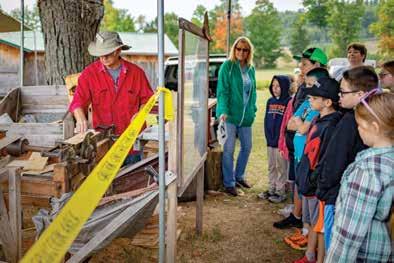
The Flywheelers welcomed 46 classes from around northern Michigan for Student Harvest Days this year, Bob said.
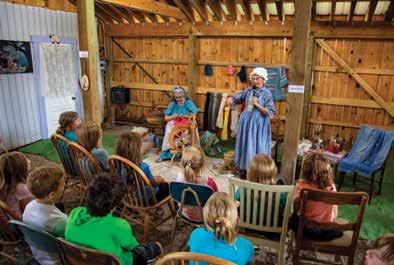
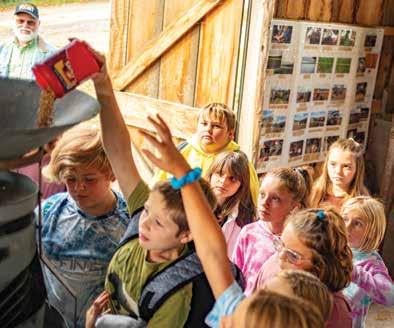
History In The Making
The Flywheelers’ organization traces its roots back to April 1988, when 27 people gathered to listen to Larry Matthews’ idea of starting an antique engine show in the Walloon Lake area. Four months later, the organization that came to be known as the Northern Michigan AntiqueFlywheelers Club had been officially formed, and members hosted its first show on the Matthews farm on U.S. 131 on the last full weekend of July.
According to its articles of incorporation, the group’s purpose is: “to promote the interests of forestry, agriculture, horticulture, household arts, mechanical arts, and sciences of historical value; to conduct annual public educational exhibitions of historical value; and to promote charitable, educational, and historical purposes.”
For the first four years, the annual show took place on the Matthews farm. Then in 1991, the group purchased the property that is now its showgrounds. Since then, many buildings and other attractions have been added to the site. One of the early additions was a Sinker-Davis Sawmill Model #53. Bob noted that the lumber for many of the buildings that are now on the showgrounds was cut on that mill using logs donated from the area.
The Flywheelers’ main sources of revenue used to support its projects and programs come from admissions and food sales during each year’s show. Bob said that’s why grants from sources such as the People Fund play a key role in the organization’s success. To mark the group’s 25th anniversary in 2013, Debra Matthews, daughter of founder Larry Matthews, wrote an in-depth Flywheelers history on its website. In the post, Debra notes that the dash between the words “Antique” and “Flywheelers” in the group’s name is there for a specific purpose: “The dash reminds us that we are not just old tractors and engines, but everything antique,” Debra wrote.
For more information about the Northern Michigan Antique-Flywheelers Association—including how to become a member and a detailed club history—visit the organization’s website at walloonlakeflywheelers.com/.
Students watch as Northern Michigan Antique-Flywheelers Club members demonstrate yarn spinning and other common household tasks during the group’s Harvest Days in September.
Students dump kernels of wheat into a grist mill at the Northern Michigan Antique-Flywheelers Club showgrounds during Harvest Days in September.
Students watch as a Northern Michigan Antique-Flywheelers Club member demonstrates making wooden shingles during the club’s Harvest Days in September.
13MICHIGAN COUNTRY LINES
A Story 100 Years In The Making
With Mammoth Distilling
By Emily Haines Lloyd
When Chad Munger held just a palmful of Rosen rye seeds in his hand in 2020, it was the beginning, or at least the continuation, of a 100-year-old story.
Munger, the founder and owner of Mammoth Distilling, with its flagship tasting room in Central Lake, and whiskey maker Ari Sussman had first spoken about these valuable seeds a few years earlier when he made a discovery while army-crawling his way through the agriculture and food archives at Michigan State University. He came across a full-page ad for Old Schenley rye in a 1934 issue of Vanity Fair touting that it was made with Michigan Rosen rye: “The most compact and flavorful rye kernels Mother Earth produces were used for this luxurious brand,” it said.
“Ari called me right away,” said Munger. “First, we couldn’t believe this rye had basically existed in our own backyard and we hadn’t heard of it before. And then the wheels started spinning on how to bring this rye back.”
The seeds had been successfully grown just off the Leelanau Peninsula

on South Manitou Island for the first time 100 years ago. With the seeds shipped from Eastern Europe in the early 1900s to Joseph Rosen, they eventually found a home at MSU, where Rosen worked with colleagues to test the flavor. The more the Mammoth team dug into the details, the more amazing the story became. They came to a simple conclusion— this was not your average rye.
“It quickly became coveted by the country’s top whiskey makers,” said Munger. “Unfortunately, it had a fatal flaw—it cross-pollinated very easily and would quickly lose the magical flavor that made it so special.”
Enter South Manitou Island: Being 16 miles from the Michigan coastline and not too far from MSU, it eliminated the danger of immediate cross-pollination. While Rosen rye had a good run supplying whiskey makers for decades, post-Prohibition times brought a hefty hurdle. During those “dry” years, folks had become accustomed to the low price tag of corn-based whiskey.
As the folks at Mammoth kept pulling threads on this unraveling story, they
quickly addressed the obstacles of bringing Rosen rye back, as well as introducing interested parties into the existing story of the strain.
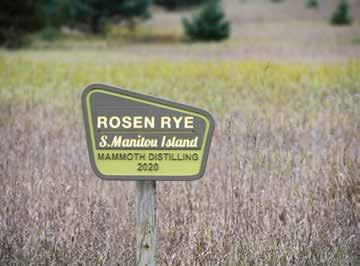
“We didn’t create it, we rediscovered it,” said Munger. “It really felt like we were being charged with keeping the story alive.”
Many amazing groups helped to keep that story alive, from the USDA, to MSU, to the National Park Service
14 NOVEMBER/DECEMBER 2022
(which manages South Manitou Island as part of the Sleeping Bear Dunes National Lakeshore), in order to bring Rosen rye back to Michigan.


The initial crop, just 14 acres, was planted in October 2020, nearly 100 years after the first seeds made their way to Michigan. Eighty years after the last crop of Rosen rye left South Manitou Island, members of the Mammoth team celebrated the first Rosen Rye Day this past August to harvest the grain. The hope is to continue this historical process for years to come.
None of it has been easy. Or even logical. Farming on South Manitou Island comes with its own set of unique obstacles, including no irrigation, no pesticides, a lot of work done by hand, and concerns that the team won’t know for years how the whiskey will taste.
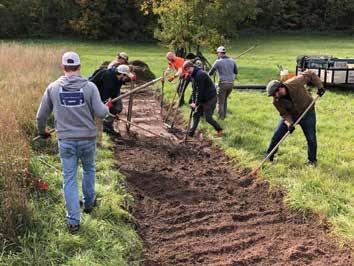
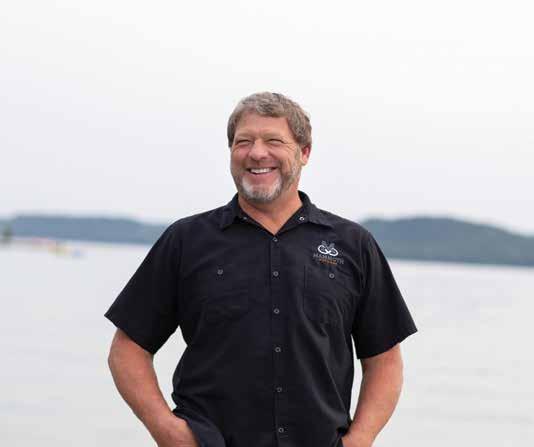
So, why do it? Why spend the time, energy, and, let’s be honest, money on a venture that may never pay off? Munger suggests that the entire team, including those at Michigan State,
the NPS, and the whiskey community at large, all agree—“Because it’s the right thing to do. Bringing the grain back is good for the world.”
If that’s the “why,” Mammoth is certainly slogging their way through the “how.” Watching the research, the passion, the grit, the sweat on the brow, and the vision, it’s not a simple path and it takes more than falling in love with a great story. It takes a leap of faith.
Munger identifi es the simple, but not at all easy, path forward: “All we need to be willing to do is the unreasonable thing.”
Unreasonable or not, there’s an excitement around this agricultural rediscovery and a connection to history, land, and rich storytelling that is at the heart of Mammoth Distilling.
Mammoth Distilling has locations in Adrian, Bay Harbor, Bellaire, Central Lake, and Traverse City.
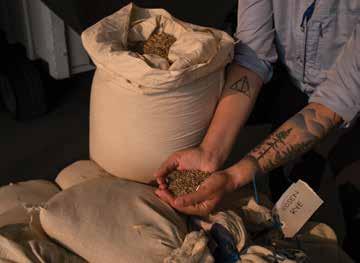
“We didn’t create it, we rediscovered it. It really felt like we were being charged with keeping the story alive.”
CHAD MUNGER—OWNER, MAMMOTH DISTILLING
/mammoth_distilling mammothdistilling.com /MammothDistillingTC 15MICHIGAN COUNTRY LINES
The Deater family’s holiday light display has been delighting Hesperia-area residents for many years.
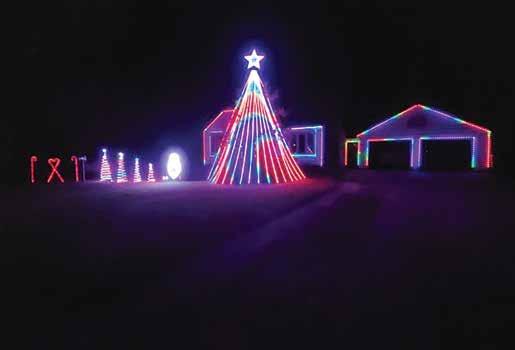
BRIGHTMaking Spirits
We have always enjoyed putting lights up on our house for the holidays. I have great childhood memories of helping my dad put lights on the house and of our family piling into the car on Christmas Eve to drive around looking at lights on area houses.
Although putting the lights up was always a big chore, they always looked so nice when it was done. Some years, we liked our multicolor lights—other years, we preferred solid colors. Thanks to my familiarity with LED pixel lights through my work in theater settings, we transitioned to lights that allowed more flexibility in our display.
These lights allow us to choose what colors we want without changing the lights. One set of lights can do whatever color scheme we want at any time.
We had not planned on it turning into a light show.
With more free time because of COVID, we started dabbling in synchronizing the lights to different songs. Little did we know what it would grow into.
Our first year was pretty rough, learning it as we went, but the feedback we received from people was amazing and really cemented our commitment to continue our show.
By the second year, we had learned much more about this crazy hobby.
We made a lot of improvements and got the kids involved in “pushing pixels,”—the process of installing the lights into the mounting brackets. Throughout the year, we keep an eye on yard sales for decorations that we can integrate into our show.
This year, we have expanded quite a bit. We currently have more than 6,000 individually controllable LED lights in our show. We love watching out the window as kids dance in the driveway, singing along to their favorite songs.
People often ask how much our electric bill has increased because of
the display, but amazingly, these lights are more efficient than even the LED lights we previously used. Of course, none of this would work without the great, reliable electricity we get from Great Lakes Energy.
Although installing the lights only takes a couple of days, sequencing the songs and creating the different props takes much longer. Programming a song can take from six hours to multiple days. It has become a yearround project, creating different props and tweaking programming.
Our show starts the weekend after Thanksgiving and will run every night through the new year. The show lasts around 45 minutes and runs multiple times throughout the evenings, starting at the top of the hour. A lowpower FM transmitter lets you tune into the music in your car. Search for “Deater Family Light Show” on Facebook for updates and plenty of behind-the-scenes pictures and information. The show is four miles west of Hesperia on Garfield Road in Oceana County.
Tim Deater works on programming his family’s holiday lighting display.

The Deaters’ youngest daughter Trinity works on installing LED lights in a mounting bracket for the family holiday light display.
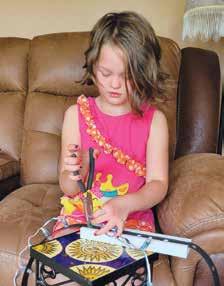 Submitted by Tim Deater, Great Lakes Energy member
Submitted by Tim Deater, Great Lakes Energy member
16 NOVEMBER/DECEMBER 2022
Tips For Safe Generator Use
When winter’s winds begin to blow each year, they bring with them the chilling thought of power outages.
While Great Lakes Energy crews always work as quickly as they safely can to restore power following a storm, for some people, making the investment in a generator that can keep the lights on and some appliances running until electric service is restored is reassuring. For less than $1,000, a portable generator can provide just enough power to keep some essentials running. For a more sizable investment, a standby generator can automatically turn on to provide nearly all your home’s electric needs until electric service can be restored.
While having a generator can be a blessing in a power outage, it’s important to be aware of several essential safety considerations ahead of time. It could be a matter of life and death.
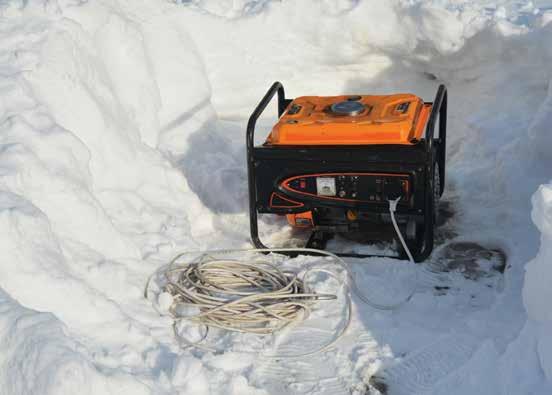
Here are the top-five safety considerations to keep in mind regarding generator use during a power outage.
Do not connect a portable generator yourself to your home wiring. Hire a licensed electrician to install a transfer switch safely. Although meter bases equipped with a built-in transfer switch can be purchased from Great Lakes Energy, GLE does not install transfer switches or meter bases. Contact a licensed electrical contractor for installation. Contact us for more information about meter base transfer switches.
If not properly isolated from the outside electrical grid by a transfer switch, electricity from a generator connected to a home’s wiring system can flow back into the power lines, endangering the lives of those working to restore your power. Downed power lines can become energized, endangering family members and neighbors nearby. Always assume a downed power line is energized and keep clear.
3 DAMAGE TO HOME APPLIANCES AND HOME ELECTRONICS
Another good reason to make sure a transfer switch is installed and used when your home’s generator is operating is that serious electrical damage could result to electronics and appliances in your home if power from the generator and Great Lakes Energy both flow into your home at the same time.
FIRE RISK
Especially for portable models, be sure not to overload a generator. This can lead to overheating and poses a fire hazard. Also, do not refuel the generator until it has cooled off. If you don’t wait, you could cause an explosion.
BEWARE OF DEADLY CARBON MONOXIDE POISONING
Again, this warning is mainly directed at portable generator models. Operate the generator outdoors and protect it from rain and other moisture. Invest in a nonflammable cover to keep it dry. The generator should be at least 25 feet away from the house and doors, windows, and vents. Operating a generator in a garage can result in the buildup of deadly carbon monoxide.
For additional generator safety tips, visit gtlakes.com/poweroutages. If you have a generator, please contact GLE at (888) 485-2537 to let us know so we can add a note to your account.
1DON’T DO IT YOURSELF 2 ELECTRIC SHOCK RISK TO LINEWORKERS OR OTHERS
4
5
17MICHIGAN COUNTRY LINES
The Salted Christmas Goose
 By Gene Comero, a HomeWorks Tri-County Cooperative member
By Gene Comero, a HomeWorks Tri-County Cooperative member

Violet Comero, in her own words.
On Christmas Day, Ma always got up first and stuffed the Christmas goose. This year was no different. She stuffed the goose and salted it and put it in the oven, and then went to the barn to do her chores. In the meantime, Papa got up and started the stove in the dining room. Before he went to the barn, he checked on the goose. He thought it didn’t look like Ma salted it, so he salted it and went to the barn.
After a while, my oldest sister got up to make breakfast. She checked the goose and thought it didn’t look like it had been salted, so she salted the goose some more. Later in the morning, Grandma Haeuser showed up, and the first thing she does is go to the kitchen to help. Well, she had to check the goose, too. Didn’t look like anyone salted it, so the poor goose got some more salt.
Everything was smelling good, and we could hardly wait. Finally, we sat down to eat. We all had goose, but no one was eating it. Then they started talking about it and realized what they had done. It was bad. It sat in the house till the next day, but nobody would eat it. So Ma threw it outside for the dog. He wouldn’t eat it, nor the cats. It remained around outside all winter. It would get covered with snow, and some animal would smell it and dig it up again, and leave it lying. That poor goose floated around the yard all winter. In spring, someone felt sorry for it and buried it.
There was much more communication in the house (kitchen) after that.
Where In Michigan Is This?
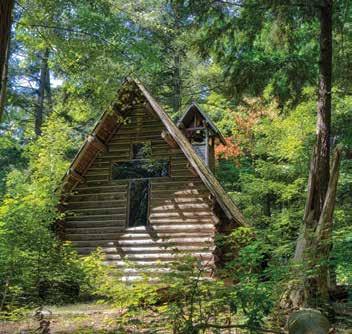
Identify
September 2022 Winner! Our Mystery Photo winner is Nancy Root, a Great Lakes Energy Cooperative member, who correctly identified the photo as Cranbrook Orpheus Fountain on its campus in Bloomfield Hills.
Winners are announced in the following issues of Country Lines: January, March, May, July/August, September, and November/December.

the correct location of the photo to the left by Nov. 20 and be entered into a drawing to win a $50 electric bill credit. Enter your guess at countrylines.com/community.
Guest Column
Share your fondest memories and stories. Win $150 for stories published. Visit countrylines.com/community to submit. Win $150! Win a $50 energy bill credit!
Memories from 1925, from my mother,
TIRED OF BURNING WOOD?

“When I could no longer physically cut 20 cords of wood, I installed a Well-Connect. The system has met all claims and surprised me. If people are heating and cooling with propane, fuel oil, or wood and have their own well, they have a need and don't realize it. That need is to cut those heating & cooling costs by at least half (as well as emissions).”
Jess S., Cherryland Electric Member


HOW DOES THE SYSTEM WORK?
This hybrid approach allows almost any existing well to become a free, clean energy source for heating and cooling your home. A Well-Connect can be installed in one day, any time of the year, as a DIY or professionally.

CALL FOR A FREE HOME VISIT wellconnectgeo.com989-356-2113
Hybr d Geotherma EXISTING FURNACE 50° WATER 38° WATER 95° AIR 70° AIR Geothermal Made Affordable ELIGIBLE FOR UP TO $2,000 REBATE & 30% TAX CREDIT Michigan-Made Hybrid Geothermal System Provides Savings & Comfort
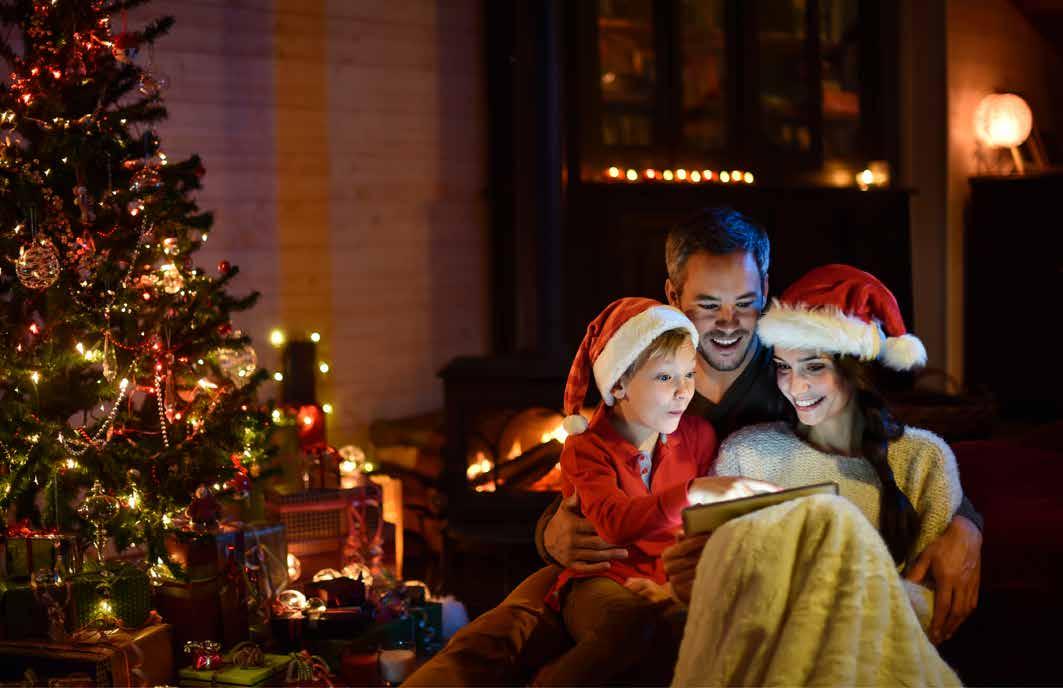
no d ata ca ps no cont rac ts speed s u p to 1 G ig P l a n s s t a r t a t $59. 99 /m o*• Internet at t he Speed of… Sig n u p now at truestreamfiber.com • 1-888-485-2537 | truestreamfiber.com N o mat te r how rural your home may b e, Truestream high spe e d inte rnet and voice se r vices allows you to stay connec te d to what matters most. Register today for free in-home installation (a $149 value).* *Certain restrictions may apply. Vacation and business plans also available. Visit truestreamfiber.com for details and construction timelines































 Submitted by Tim Deater, Great Lakes Energy member
Submitted by Tim Deater, Great Lakes Energy member

 By Gene Comero, a HomeWorks Tri-County Cooperative member
By Gene Comero, a HomeWorks Tri-County Cooperative member







